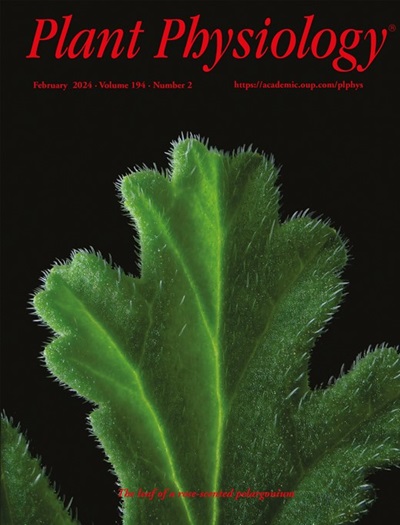Ubiquitination of the PpMADS2 transcription factor controls linalool production during UV-B irradiation in detached peach fruit
IF 6.9
1区 生物学
Q1 PLANT SCIENCES
引用次数: 0
Abstract
Plant secondary metabolites undergo changes in response to UV-B irradiation. Although UV-B irradiation reduces flavor-associated volatile compounds in detached peach (Prunus persica L. Batsch) fruit, the underlying regulatory mechanisms remain unclear. By integrating proteomic, transcriptomic and metabolomic data from peach fruit following UV-B irradiation, we discovered that the detached fruit responds to UV-B by suppressing the biosynthesis of the flavor-related monoterpene linalool. We identified PpMADS2, a transcription factor that regulates linalool biosynthesis by activating terpene synthase 1 (PpTPS1) expression. PpMADS2 overexpression in peach and tomato fruits significantly increased linalool levels compared to the controls. Proteomic data and immunoblots revealed a decrease in PpMADS2 abundance following exposure to UV-B. Moreover, our results demonstrated that PpMADS2 interacts with the E3 ubiquitin ligase PpCOP1 both in vitro and in vivo. The UV-B induced 26S-proteasome-mediated degradation of PpMADS2 is largely PpCOP1-dependent. Taken together, our findings demonstrate that linalool biosynthesis in detached peach fruit exposed to UV-B radiation is governed by the PpCOP1–PpMADS2–PpTPS1 module. This study enhances our understanding of the interplay between light signaling and fruit flavor quality. Multi-omics approaches offer valuable resources for investigating the mechanisms underlying how light influences metabolism in fruit crops.PpMADS2转录因子的泛素化控制着UV-B辐照下桃果离体芳樟醇的产生
植物次生代谢产物在UV-B照射下发生变化。虽然UV-B辐照降低了离体桃果中与风味相关的挥发性化合物,但其潜在的调控机制尚不清楚。通过整合UV-B照射后桃果的蛋白质组学、转录组学和代谢组学数据,我们发现离体桃果对UV-B的反应是通过抑制与风味相关的单萜烯芳樟醇的生物合成来实现的。我们确定了PpMADS2,一个通过激活萜烯合成酶1 (PpTPS1)表达来调节芳樟醇生物合成的转录因子。PpMADS2在桃子和番茄果实中的过表达与对照相比显著增加了芳樟醇水平。蛋白质组学数据和免疫印迹显示暴露于UV-B后PpMADS2丰度降低。此外,我们的研究结果表明,PpMADS2在体外和体内都与E3泛素连接酶PpCOP1相互作用。UV-B诱导的26s蛋白酶体介导的PpMADS2降解主要依赖于ppcop1。综上所述,我们的研究结果表明,暴露于UV-B辐射的离体桃果中的芳樟醇生物合成受PpCOP1-PpMADS2-PpTPS1模块的控制。本研究加深了我们对光信号与水果风味品质之间相互作用的理解。多组学方法为研究光如何影响水果作物代谢的潜在机制提供了宝贵的资源。
本文章由计算机程序翻译,如有差异,请以英文原文为准。
求助全文
约1分钟内获得全文
求助全文
来源期刊

Plant Physiology
生物-植物科学
CiteScore
12.20
自引率
5.40%
发文量
535
审稿时长
2.3 months
期刊介绍:
Plant Physiology® is a distinguished and highly respected journal with a rich history dating back to its establishment in 1926. It stands as a leading international publication in the field of plant biology, covering a comprehensive range of topics from the molecular and structural aspects of plant life to systems biology and ecophysiology. Recognized as the most highly cited journal in plant sciences, Plant Physiology® is a testament to its commitment to excellence and the dissemination of groundbreaking research.
As the official publication of the American Society of Plant Biologists, Plant Physiology® upholds rigorous peer-review standards, ensuring that the scientific community receives the highest quality research. The journal releases 12 issues annually, providing a steady stream of new findings and insights to its readership.
 求助内容:
求助内容: 应助结果提醒方式:
应助结果提醒方式:


